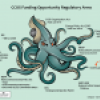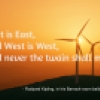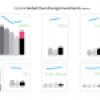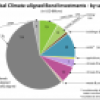Mystique Of Wind - Part 2
It was speculated in Part 1 that wind power has held a fascination in our minds since ancient times, and still does. One year later here is Part 2, also written in 2009, at which time there were 23,000 turbines installed, capable of generating more than 38 GW of wind energy pushing the total figure to 160 GW. Hold that thought and then consider that globally somewhere around one to two percent of electricity we humans use comes from wind turbines [see David Beattie's 12.22.10 World Energy post].
Only in the last two decades of the 20th Century did the technology of windmills sprout into hundreds of acres of hundreds-of-feet tall turbines capable of producing—in perfect weather conditions—hundreds of megawatts of electricity that could theoretically power hundreds of thousands of homes. Wind power remains mystical in large part because of the four-dimensional conversation by the media, bloggers and numerous wind industry participants.
The four dimensions are: number of turbines, combined rated (not produced) energy of turbines, land or sea occupied by turbines, and last of all or #4, the first three expressed as the equivalent number of homes that could be powered by the electricity that could be theoretically produced. What we get from the wind contingency is clean energy loosely defined so as to ensure that the mystique (aka missing information) continues to fuel our naive fascination with the power of wind.
What follows is a look at some elementary details about producing electricity from Mother Nature when it comes to wind and weather.
Wind farms around the world come in various permutations of mostly European and Chinese manufacturers and vintages. It took several generations to begin to understand and begin to perfect the design of the turbines themselves as well site specific installation details. Some of the things the wind industry has discovered through research and development and trial by error, is that the turbines so far generate electricity when the wind is blowing from around 5 to 55 miles per hour ( 2 to 25 meters per second). No electricity is produced if the wind is too weak or too strong.
Although there are too many characteristics of wind to list here, the media and press releases diminish environmental and regulatory complexity of siting and developing wind farms using catchall words such as "intermittency" or "variable". But such tactics do little to inform and much to heighten appeal, warranted or not.
How much more interesting would it be if the details were spread to common knowledge? Wind speed can within a second, for example, vary from 10 to 35 mph (16 to 56 kph). Yet with the aggregation of multiple wind turbines on a wind farm (or nearby transmission lines), the fast variations (seconds to minute) of aggregated wind power output as a consequence of turbulence or transient events may be quite small. Combining wind and solar together with other energy sources is also a means of balancing intermittency. So far any specifics about feeding wind's temperamental juice into grid systems is not readily shared with the public even though billions are quietly being approved toward such solutions.
Besides how to interconnect the variability of wind power into the power grid, wind's volatility also affects turbine design. Within and hour wind speed within can jump from 70 to 100 mph (112 to 160 kph). The variations within an hour stem from the degree of local geographical diversity, but are much more significant for the system and have to be considered in relation to demand fluctuations. Depending on a turbine’s particular vintage, of course, at somewhere around 60 mph (95 kph) turbines need to be shut down to avoid damage.

The blades attach to the rotor which converts the linear motion of the wind into rotational energy that can be used to drive the generator (or turbine, pronounced tur-bin). The blades which are usually colored light gray to blend in with the clouds (and subsequently camouflage their presence from people and birds alike) range in length from 65 to 130 feet (20 to 40 meters) or more, which makes them difficult and expensive to transport and therefore makes it economical to manufacture them close to where they will live. Newer offshore wind projects which if funding steadies, stand to realize benefits from reduced sea transport costs.
The media has a role to play, but it is not the current practice of touting the equivalent number of homes a wind or solar farm could theoretically power according to a pre-set percentage as defined by a regulatory process (more on this in Part 3). The more the public and government officials understand about technological opportunities and the hurdles posed by the economics of adding transmission lines, upgrading an outdated power grid, for example, by economically stimulating the development of battery technology to store renewable energy or co-locate complementary power production, the sooner the U.S. will be able to muster the political will to compete on the global market and run head to head with European and Chinese wind power generation industry.
There are positive signs in the U.S. that clean technology is pushing a toehold into the marketplace. One such signal comes from Manassas, Virginia based Catch the Wind, Ltd’s (TSX-V: CTW.S) laser based Vindicator wind sensor technology. Up until now wind turbines have relied on animometers to gauge the speed and direction of wind. Based on sensor technology developed for the military, sending out lasers 300 feet, the sensor measures the direction and turbulence of the wind and enables the turbines orientation and rotation speed to be more efficiently adjusted. In December 2009, CTW released the results of a 30-day trial with Nebraska Public Power District claiming the output of a turbine increased by an average of 12.3 percent as a result of better alignment with oncoming wind and increased gust detection when the sensor controlled the turbine for only 56 percent of the and that energy output increased by more than 18 percent.




